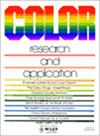Aging and Color Vision: A Model Using the Farnsworth-MUNSELL 100-Hue Test
Abstract
Introduction
This study examined the theoretical changes in the FM100 Hue scores induced by age-related changes in the ocular media transmittance. These changes were analyzed with and without a von Kries-type chromatic adaptation to determine the role of this adaptation process on age-related changes in hue discrimination.
Methods
We calculated the CIECAM02 chromaticity coordinates of the FM100 Hue caps for 32- and 74-year-old ideal observers. The chromaticity coordinates were calculated using the CIE D65 illuminant, the individual caps' spectral reflectances, and the CIE 1931 2° color matching functions. We modified the spectral distribution of the D65 light source using the model of Pokorny et al. and the van de Kraats-van Norren model of media transmittance to account for the age-related changes by 74 years. We accounted for the decrease in retinal illuminance due to pupil miosis and ocular media spectral transmittance in the old observers. The predicted ordering of the FM100 Hue caps was based on the minimum color differences (ΔE) between nearby caps, calculated using the CIECAM02 model.
Results
Reported outcomes were obtained for specific model parameters: adapting luminance (31.9 cd/m2); illuminance (500 lx); stimulus diameter (20°); surface reflectance 20%; CIE illuminant D65; CIE 1931 2° color-matching functions/XYZ-values; pupil size (4.35 mm for young observer and 3.46 mm for old observer models). The total error score (TES) increased from 8 for the 32-year-old observer to 12 for both 74-year-old observer models when complete and partial adaptation factors were applied. The increase in TES for the 74-year-old observer models was in the blue–blue-purple band, which was along the red-green axis. Without any adaptation for the old observer models, the error scores increased further. The increase was in the red–green score for the van de Kraats–van Norren model, whereas the increase for the Pokorny et al. model was in both the red–green and blue–yellow error scores. Overall, the mean color differences for the old observer models decreased uniformly under complete and partial adaptation.
Conclusion
The predicted effect of age-related changes in media transmittances on the FM100 Hue test showed an increase in the TES; however, the increase was primarily due to an increase in the red–green error score. This disagrees with the psychophysical data, which show a greater increase in the blue–yellow error score, thus suggesting the presence of age-related neural changes. The two models for age-related changes in media transmittance produced similar results under complete chromatic adaptation.


 求助内容:
求助内容: 应助结果提醒方式:
应助结果提醒方式:


